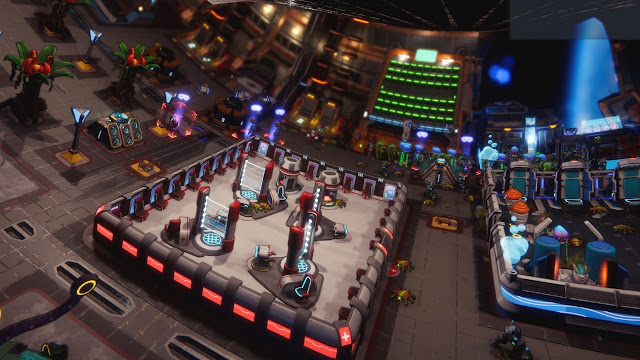I know that space is a cold place and all, but that doesn’t mean that games set in space should leave me feeling cold. Unfortunately, Spacebase Startopia, which does try to be a satirical simulator in the vein of Two Point Hospital et al, has left me feeling very cold indeed. It’s disappointing, given that it’s published by Kalypso, a publisher that usually has such an eye for this genre. It’s hard to believe that the same company that, in just the last couple of years, has brought us consistent excellence in Port Royale 4, Tropico 6, Immortal Realms, Railway Empire and Dungeons 3 would think that this is a good idea.
For one thing, if you tell me that I am going to be able to play a space station builder simulation, I kind of expect to see space. I want to see the station slowly grow from the outside, floating in the void of space. I want to have a sense of what I am doing is in that context, too. I want to be able to advertise my recreational facilities to various planets, and then watch ships of space tourists turn up. I want to build domed “outdoor” areas and provide my visitors with parks that they can stargaze from. Again, I want to see space. With Spacebase Startopia, you instead see little more than the inside of doughnuts. Sure it’s all metal and the way it is curved gives it a “science fiction” look, but it’s claustrophobic and, frankly, aesthetically unpleasant, and the only relief is the tiniest window that hints at what’s outside. Whether it’s Planet Coaster, Two Point Hospital or Project Highrise, I care a great deal about the aesthetics in simulators, as I like to watch the results of my decisions turn into a growing, thriving, thing (whatever it is that I’m building). I could never muster the will to care in Spacebase Startopia, and for a genre as time-consuming as this one, that’s a big problem.
Mechanically it is standard genre stuff, but competently structured. This space doughnut has three different “tiers,” which are separated physically as three sets of separate doughnut rings. One tier is full of organic plants, and it produces the raw materials that you use in a second-tier to build rooms, items, and objects to keep your visitors happy. The third tier is purely for recreational pursuits, and it drains a lot of resources to maintain, but does so in exchange for a lot of in-game currency. The symbiosis between these three tiers is simple and obvious, but it does force you to keep flicking between the three of them and micromanaging a lot of moving parts within the starbase. Deep into the game, this feels like relentless busywork, but the strategy behind the game is so simplistic that it’s the only engaging quality it has going for it.
Of course, you have to make sure that all these aliens are happy and healhty, so you’ll need medical facilities, plenty of garbage bots to clean away the trash, and the disco and arcade to give them all distractions from their meaningless existences on board your space ship. There are plenty of buildings to construct, and space is at a premium, so you do need to play Tetris to an extent, but I didn’t find the linkages between the various buildings to be particularly compelling. Another space-themed simulator, Aven Colony, which I loved on the PlayStation 4, was about setting up a base on a planet rather than in space, but with a similar theme it offered a much more nuanced set of interactions between buildings that resulted in more strategic, considered gameplay. With Aven Colony every building would shift a half dozen needles in both positive and negative directions, and you needed to carefully manipulate future construction with an eye to strike the best balance. Meanwhile, with Spacebase Startopia, it inevitably feels like your only goal is to expand as quickly as possible to have the land space to plug the obvious gaps that need plugging. It’s a story of one solution (build something) to solve one problem (a lack of something), and the only consequence to that is having less space to build the next cork plug to solve the next leaking barrel.
But I think it’s the game’s misguided sense of humour that really ended up annoying me. Humour is hard, I do understand that, but there is a fine, but definite line between dry sarcasm or droll, biting humour, and outright mockery. Spacebase Startopia opts for the latter, and the AI-like “helper” that walks you through the tutorial and then natters away throughout a mission can barely go a sentence without calling you an idiot, regardless of context. Finish a level quickly? The script tells VAL the AI to mock you for being slow. Keep your people in a state of delirious happiness? You’ll get mocked for your competence being a “surprise” to VAL, even if you’ve made it a deliberate focus and spent 15 minutes on it, showing mastery over being able to form a plan to solve your alien visitor’s moods. The developers clearly borrowed inspiration for VAL from Portal’s GLaDOS, without apparently realising that GLaDOS worked so well because the biting humour was contextual to what was actually going on in that game.
Spacebase Startopia is not completely without merit, but it does lack in charm and depth, and simulators need one or the other (and preferably both) else they’re in big trouble. With that being said there is a very specific audience for this game; it works as a competitive simulator where you learn the perfect order for doing things and then execute on that to cruise through to easy victories. In almost any other context, however, Spacebase Startopia lacks the creative whimsy and data-driven depth that we usually expect from a great simulator.










